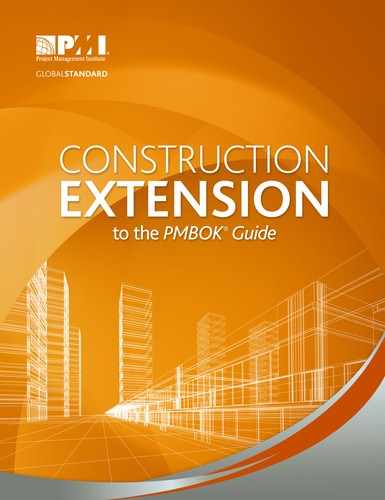TABLE OF CONTENTS
1.2Purpose and Audience for the Construction Extension
1.3Context and Structure of the Construction Extension
1.5The Role of the Project Manager in Construction and Special Areas of Expertise
1.5.1The Role of the Project Manager in Construction
1.5.2Special Areas of Expertise
2. THE CONSTRUCTION PROJECT ENVIRONMENT
2.1Organizational Influences on Construction Project Management
2.1.1Types of Construction Projects
2.1.3Organizational Structures
2.1.4Enterprise Environmental Factors
2.2Project Stakeholders and Governance
2.2.3Social Responsibility and Sustainability
3. PROJECT MANAGEMENT IN THE CONSTRUCTION INDUSTRY: OVERVIEW AND ADVANCEMENTS
3.1Project Management Knowledge Areas, Process Groups, and Processes
3.1.1Project Integration Management
3.1.3Project Schedule Management
3.1.5Project Quality Management
3.1.6Project Resources Management
3.1.7Project Communications Management
3.1.9Project Procurement Management
3.1.10Project Stakeholder Management
3.1.11Project Health, Safety, Security, and Environmental Management (HSSE)
3.1.12Project Financial Management
3.2Advances and Societal Influences in Construction Project Management
3.2.1.2Building Information Modeling (BIM)
3.2.1.3Modern Methods of Construction
3.2.2Societal Influences in Construction
3.2.2.1Sustainability and Social Responsibility
3.2.2.2Skilled Human Resources
3.2.2.3Global and Regional Recessions (Global Economies)
3.2.2.4Global Markets and Future Projects
4. PROJECT INTEGRATION MANAGEMENT
4.1Project Integration Management in Construction
4.2Project Integration Management Initiating
4.2.2Enterprise Environmental Factor Considerations
4.2.3Project Service Provider Engagement
4.3Project Integration Management Planning
4.3.3Intermittent Contract Closures and Commissioning
4.4Project Integration Management Executing
4.4.1Work Performance and Inspection
4.4.2Value Engineering in Executing
4.4.3Construction Administration
4.4.4Initiate and Manage Partnering
4.5Project Integration Management Monitoring and Control
4.5.2Integrated Change Control
4.5.3Sources of Problems with Project Changes
4.6Project Integration Management Closing
4.6.4Beneficial Occupancy and Substantial Completion
4.6.6Final Project Report and Lessons Learned
4.7Integration Management Advancements
5.1Project Scope Management in Construction
5.2Project Scope Management Planning
5.3Project Scope Monitoring and Control
5.3.1Scope Validation/Verification
5.3.1.1Request for Information (RFI)
5.3.2Scope Creep and Change Management
6. PROJECT SCHEDULE MANAGEMENT
6.1Project Schedule Management in Construction
6.2Project Schedule Management Planning
6.2.1.1Work Breakdown Structure
6.2.1.4Progress Measurement Plan and Criteria
6.2.3Estimate Activity Resources
6.2.4Estimate Activity Durations
6.2.5Activity Weightage Definition
6.2.6.1Vendor or Subcontractor Schedule Analysis
6.2.6.6Schedule Risk Analysis (SRA)
6.2.7Progress Curves Development and Update
6.2.7.1Weights Distribution Standard Curves
6.3Project Schedule Management Monitoring and Control
6.3.3Progress and Performance Reviews
7.1Project Cost Management in Construction
7.2Project Cost Management Planning
7.2.1Estimating Costs and Techniques
7.2.1.1Analogous (Conceptual) Estimating
7.2.1.3Bottom-Up (Detailed) Estimating
7.2.2Bill of Materials (Bill of Quantities)
7.2.3Allowances, Contingency, and Management Reserve
7.2.4Escalation, Inflation, and Currency Exchange
7.2.6Additional Considerations in Estimating
7.2.7.1Construction Work Package (CWP)
7.3Project Cost Management Monitoring and Control
7.3.3Progress and Performance Reviews
7.3.4Forecasting or Estimate at Completion
8.1Project Quality Management in Construction
8.1.2Modern Quality Management
8.2Project Quality Management Planning
8.2.2Project Stakeholder Requirements
8.2.4Quality Assurance Measurements
8.2.6Project Requirements Review
8.3Project Quality Management Executing
8.3.2Quality Management Reviews
9. PROJECT RESOURCE MANAGEMENT
9.1Project Resource Management in Construction
9.2Project Resource Management Planning
9.3Project Resource Management Executing
9.4Project Resource Management Monitoring and Controlling
9.5Project Resource Management Closing
10. PROJECT COMMUNICATIONS MANAGEMENT
10.1Project Communications Management in Construction
10.2Project Communications Management Planning
10.2.1Communications Management Plan
10.2.2Project Documentation Assessment
10.2.4Corporate Communication and Social Responsibility
10.2.7Information and Communication Technology (ICT), Project Management Information System (PMIS)
10.3Project Communications Management Executing
10.3.3Project Documentation and Information Distribution
10.4Project Communications Management Monitoring and Control
10.4.1Performance and Progress Reports
10.4.3Contractor Performance Evaluation (CPE)
11.1Project Risk Management in Construction
11.2Project Risk Management Planning
11.2.1Bidding and Contract Documents
11.2.4Scoring and Interpretation
11.2.5Project Risk Management Planning Under Collaborative Construction Project Arrangements
11.2.6Project Risk Management Planning in Public-Private Partnership (PPP)
11.2.7Project Risk Management Planning in International Projects
11.2.8Risk Identification in Construction Projects
11.2.8.5Lessons Learned and Learning from Others’ Experiences
11.2.8.7Concept Hazard Analysis
11.2.8.8Preliminary Hazard Analysis (PHA)
11.2.8.9Hazard and Operational Studies (HAZOP)
11.2.8.10Constructability Review and Checklist
11.2.8.12Fault Tree Analysis (FTA)/Failure Modes and Effects Analysis (FMEA)
11.2.9Qualitative Risk Analysis in Construction Projects
11.2.10Quantitative Risk Analysis in Construction Projects
11.2.11Plan Risk Responses in Construction Projects
11.2.11.1Strategies for Negative Risks or Threats and Positive Risks or Opportunities
11.2.12Insurance in Construction Projects
11.3Project Risk Management Monitoring and Controlling
12. PROJECT PROCUREMENT MANAGEMENT
12.1Project Procurement Management in Construction
12.1.1Contractor's Perspective
12.2Project Procurement Management Planning
12.2.1Procurement Management Plan
12.2.2Enterprise Environmental Factors
12.2.4Organizational Process Assets
12.2.7Other Service Provider Procurements
12.2.9Project Delivery Methods
12.2.9.2Integrated Project Delivery and Turnkey Approaches
12.2.11Contract Risk Allocation
12.2.12Procurement Planning Outputs
12.3Project Procurement Management Executing
12.3.1Procurement Solicitation
12.3.2Contract Statement of Work
12.3.4Prequalification of Service Providers
12.3.5Nongovernment Organizations (NGO) Solicitation of Seller Responses
12.3.6Public and Government Solicitations
12.3.7Evaluation and Selection of Sellers
12.3.8Single-Source Procurement
12.4Project Procurement Management Monitoring and Controlling
12.4.1Contract Management and Contract Administration
12.4.2Work Performance Reporting
12.4.3Approved Change Requests
12.4.4Buyer-Conducted Performance Review
12.4.8Records Management Systems
12.4.9Project and Contract Documentation
12.4.10Project Management Plan Updates
12.5Project Procurement Management Closing
13. PROJECT STAKEHOLDER MANAGEMENT
13.1Stakeholder Management in Construction
13.2Project Stakeholder Management Initiating
13.3Project Stakeholder Management Planning
13.4Project Stakeholder Management Executing
13.5Project Stakeholder Management Monitoring and Controlling
14. PROJECT HEALTH, SAFETY, SECURITY, AND ENVIRONMENTAL (HSSE) MANAGEMENT
14.1Project Health, Safety, Security, and Environment Management in Construction
14.2Project HSSE Management Planning
14.2.2Safety and Environmental Policy
14.2.4Site Neighborhood Safety and Environmental Characteristics and Constraints
14.2.6Cost of Safety (COS) and Cost of Environment (COE)
14.2.9Project Safety and Environmental Requirements Review
14.2.11Safety and Environmental Zoning and Signage
14.2.12Safety and Environmental Training and Induction Requirements
14.2.13Traffic Management Plan
14.2.14Emergency Response Plan
14.2.15Permit to Work Management Plan
14.2.17Safety and Environmental Programs
14.3Project HSSE Management Executing
14.3.1.1Safety and Environmental Audits
14.3.1.2Safety and Environmental Hazard Risk Analyses
14.3.1.3Safety and Environmental Assurance Measurements
14.4Project HSSE Management Monitoring and Controlling
14.4.1Key Performance Indicators
14.4.2Heinrich's Accident Triangle
15. PROJECT FINANCIAL MANAGEMENT
15.1Project Financial Management in Construction
15.2Project Financial Management Planning
15.2.1Sources of Funds for Construction Projects
15.2.2Short-Term Financial Fluctuations
15.2.4Analytical Techniques, Feasibility Study, and Sensitivity Analysis
15.2.5Construction Project Finance and Corporate Finance
15.2.8Financial Impact Risk Factors
15.2.9Tax Planning as a Financial Factor
15.3Project Financial Management Monitoring and Control
15.3.1Project Accounting Systems
15.3.2Financial Internal and External Audits
